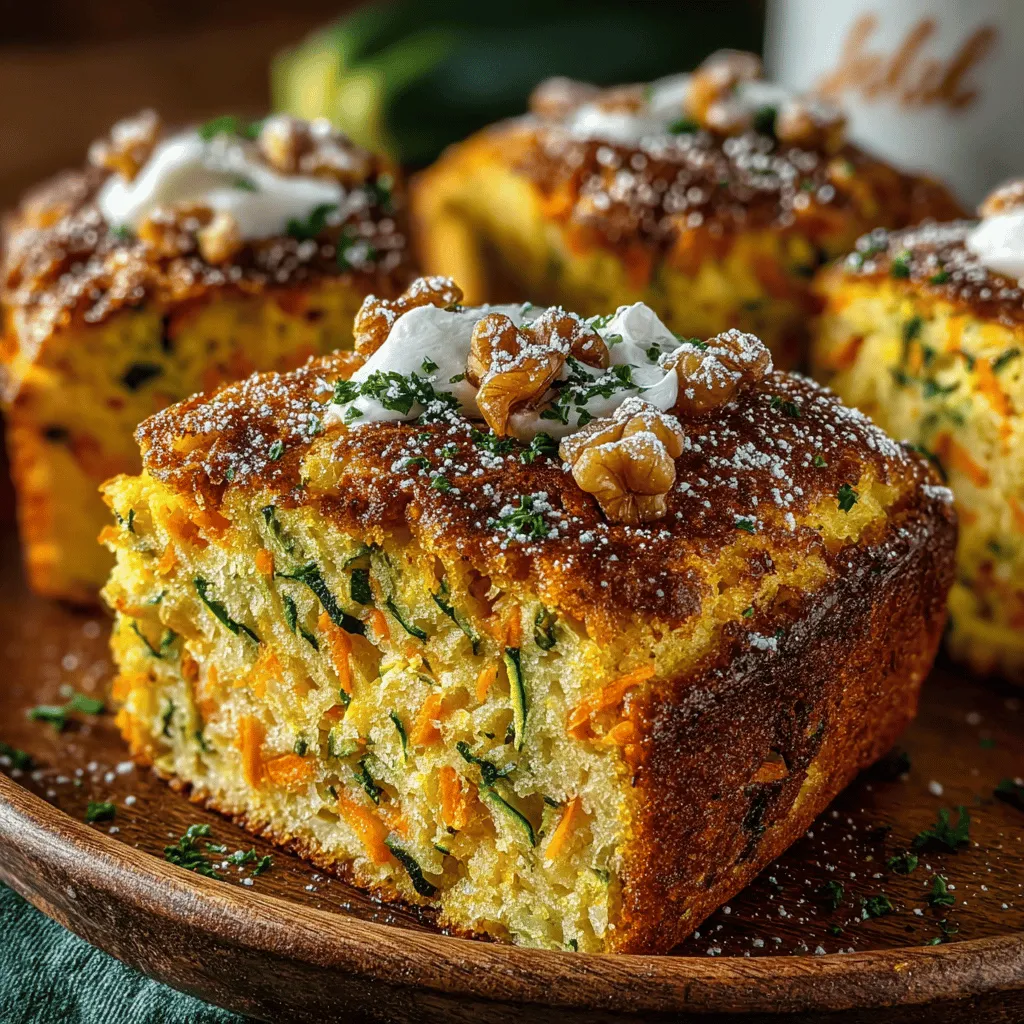Introduction
Zucchini Bread Breakfast Casserole is a delightful way to start your day, merging the comforting flavors of traditional zucchini bread with the convenience of a breakfast casserole. This dish stands out as a perfect morning meal that not only satisfies your taste buds but also nourishes your body. With the increasing popularity of meal prep and the need for quick yet wholesome breakfast options, this casserole emerges as an ideal solution for families and busy individuals alike.
Zucchini, a versatile summer squash, lends moisture and a subtle sweetness to the casserole, while the spices and other ingredients create a rich flavor profile that evokes the warmth of home baking. The moist texture and sweet spice notes make this dish enjoyable whether served warm straight from the oven or at room temperature, making it perfect for busy weekday breakfasts or leisurely weekend brunches.
In this article, we will explore the ingredients that make up this delicious breakfast casserole, a step-by-step guide on how to prepare it, and the nutritional benefits it offers. Whether you are a seasoned cook or a novice in the kitchen, we aim to ensure you have all the information needed to create a breakfast that will impress your family and friends.
Understanding the Ingredients
Zucchini: The Star of the Dish
At the heart of the Zucchini Bread Breakfast Casserole is, unsurprisingly, zucchini. This summer squash is not only the star of the dish but also a nutritional powerhouse. Zucchini is low in calories and high in vital nutrients, including vitamins A and C, potassium, and dietary fiber. These nutrients contribute to overall health by supporting immune function, promoting healthy skin, and aiding digestion.
When preparing zucchini for the casserole, one crucial step is to remove excess moisture. Fresh zucchini can contain a significant amount of water, which can make the casserole soggy if not addressed. To effectively remove moisture, grate the zucchini using a box grater or food processor and then place it in a clean kitchen towel. Twist the towel to squeeze out the excess liquid, ensuring your casserole has the right texture.
Flour: The Foundation
Flour serves as the foundation of the casserole, providing structure and a base for the other ingredients. While all-purpose flour is commonly used, you can explore various alternatives depending on dietary preferences. Whole wheat flour adds a nutty flavor and additional fiber, while almond flour or coconut flour can be great gluten-free options.
For those with gluten sensitivities or celiac disease, gluten-free flour blends are widely available and can be seamlessly substituted into the recipe. Always check the packaging for specific measurements or adjustments needed, as gluten-free flours can behave differently than traditional wheat flour.
Sweeteners: Balancing Flavor
Sweetness is a key component of the Zucchini Bread Breakfast Casserole, and the choice of sweetener can significantly affect the dish’s flavor and texture. Granulated sugar typically provides a straightforward sweetness, while brown sugar adds a rich, molasses-like flavor and contributes to moisture.
For those looking for natural alternatives, options like honey or maple syrup can also be used. These natural sweeteners offer unique flavors and may be perceived as healthier choices. However, be sure to adjust the liquid ratios in the recipe, as these sweeteners are often more liquid than granulated sugar.
Spices: Enhancing the Flavor Profile
The warmth of spices is what elevates the Zucchini Bread Breakfast Casserole from a simple dish to a flavor-packed experience. Cinnamon and nutmeg are classic choices, both of which not only enhance the flavor but also provide health benefits. Cinnamon is known for its anti-inflammatory properties and ability to stabilize blood sugar levels, while nutmeg offers antioxidants and digestive support.
Feel free to customize the spice blend to your taste. You might consider adding ginger for a bit of zing or allspice for a more complex flavor profile. The beauty of this casserole is its versatility, allowing you to experiment with different spices to find your perfect combination.
Eggs: Binding and Moisture
Eggs play a crucial role in the Zucchini Bread Breakfast Casserole, acting as a binder that helps to hold everything together while also adding moisture. If you follow a vegan or egg-free diet, there are several substitutes available. Flax eggs (made from ground flaxseeds mixed with water) or applesauce can effectively replace eggs in most recipes, providing similar binding properties.
Optional Ingredients: Elevating the Casserole
To take your Zucchini Bread Breakfast Casserole to the next level, consider incorporating optional ingredients that not only enhance flavor but also add crunch and nutrition. Chopped nuts, such as walnuts or pecans, can provide a satisfying texture and additional healthy fats. Similarly, seeds like chia or pumpkin seeds can add both nutrition and a delightful crunch.
Fruits and veggies can also be mixed in for added flavor and health benefits. Grated carrots can increase sweetness and moisture, while raisins or dried cranberries can introduce a chewy texture. For a decadent twist, consider adding chocolate chips for a sweet surprise in each bite.
Step-by-Step Instructions for Zucchini Bread Breakfast Casserole
Prepping the Oven and Baking Dish
Before you begin assembling your casserole, it’s essential to prepare your oven and baking dish. Preheat your oven to 350°F (175°C). Preheating ensures that your casserole bakes evenly and helps achieve that perfect golden-brown top.
When selecting a baking dish, consider the size and material. A standard 9×13-inch baking dish works well for this recipe, but if you prefer a thicker casserole, you can use a smaller dish. Glass or ceramic dishes are preferred for even heat distribution, but metal pans can also be used. Just keep an eye on the baking time, as metal can cook faster.
Preparing the Zucchini
Once your oven is preheated, it’s time to focus on the zucchini. As mentioned earlier, grating the zucchini is a critical step. Use the coarse side of a box grater or a food processor for quick and uniform grating.
After grating, transfer the zucchini to a clean towel and remove as much moisture as possible. Proper moisture removal is crucial for achieving a well-textured casserole that isn’t too wet. Once drained, set the zucchini aside while you prepare the other ingredients.
Mixing the Dry Ingredients
With the zucchini prepared, you can begin mixing the dry ingredients. In a large mixing bowl, combine your chosen flour with the sweeteners, baking powder, baking soda, and spices. This mixture will serve as the base of your casserole. Mixing dry ingredients together before adding wet ingredients ensures that the baking powder and baking soda are evenly distributed, resulting in a uniform rise and texture.
As you blend the dry ingredients, take a moment to appreciate the warm, inviting aroma of the spices. This sensory experience is a precursor to the delicious meal that awaits you, setting the stage for a delightful cooking experience.
Stay tuned for the next part of this article, where we will cover the remaining steps to complete your Zucchini Bread Breakfast Casserole, ensuring you have a comprehensive guide to this scrumptious dish.

Creating a Zucchini Bread Breakfast Casserole is not just about assembling ingredients; it’s about crafting a delightful dish that combines the richness of zucchini bread with the heartiness of a breakfast casserole. In this section, we will delve into the techniques for whisking, mixing, baking, and serving, ensuring you achieve the best results every time.
Whisking Techniques
Achieving the perfect Zucchini Bread Breakfast Casserole starts with thorough mixing. The goal here is to ensure an even distribution of flavors throughout the dish.
Combining Wet Ingredients
When combining your wet ingredients, start by whisking eggs, milk, and any sweeteners or flavorings you choose, such as vanilla extract. It is essential to incorporate air into the mixture as this will help create a light and fluffy casserole. Whisk vigorously until the mixture is well-blended and slightly frothy. This incorporation of air is vital as it contributes to the overall texture of the finished casserole.
Achieving the Right Consistency
Your wet mixture should be smooth and uniform, free from lumps. This consistency is crucial as it ensures that every bite of your casserole is packed with the same delicious flavor. If you’re using ingredients like yogurt or applesauce, make sure they are mixed in thoroughly to prevent any clumps in the batter.
Mixing Dry and Wet Ingredients
Once your wet ingredients are perfectly whisked, it’s time to incorporate the dry ingredients.
Combining Tips
When adding dry ingredients such as flour, baking powder, cinnamon, and salt, do so gradually. This method not only helps in minimizing lumps but also prevents overmixing. Overmixing can lead to a dense casserole rather than the tender texture we aim for. Use a spatula or wooden spoon to gently fold the dry ingredients into the wet mixture just until combined. A few small lumps are acceptable; this ensures the casserole remains tender and moist.
Folding in Zucchini and Extras
Gentle Folding Techniques
The next step is to fold in your grated zucchini, along with any extras like shredded carrots or nuts. This is where the gentle folding technique comes into play. Using a spatula, carefully lift and turn the batter over itself, incorporating the zucchini without deflating the air you’ve worked hard to create.
Make sure the zucchini is evenly distributed throughout the batter, which will help with moisture retention and flavor infusion. If you’re adding items like chocolate chips or raisins, fold them in at this stage as well for added sweetness.
Baking the Casserole
Timing and Temperature
Preheat your oven to 350°F (175°C) and prepare your baking dish by greasing it lightly. Pour the batter into the dish and spread it evenly. Bake for about 30-40 minutes, or until the casserole is golden brown on top and set in the center. The timing can vary depending on your oven and the size of your dish, so keep an eye on it.
Testing for Doneness
To ensure your casserole is perfectly baked, insert a toothpick into the center. It should come out clean or with a few moist crumbs attached. If the toothpick comes out with wet batter, give it a few more minutes in the oven. Remember, the residual heat will continue to cook the casserole slightly after you remove it from the oven, so avoid overbaking.
Serving Suggestions
Presentation Ideas
Once your Zucchini Bread Breakfast Casserole is out of the oven, let it cool for a few minutes before slicing. This cooling time allows the casserole to set further, making it easier to cut into neat squares or wedges. For a visually appealing presentation, serve the casserole on a beautiful platter, garnished with fresh herbs like parsley or chives. You could also sprinkle powdered sugar on top for a touch of sweetness.
Pairing Options
To enhance the breakfast experience, consider pairing the casserole with fresh fruit, a dollop of yogurt, or a drizzle of maple syrup. Complementary beverages such as freshly brewed coffee, herbal tea, or a refreshing smoothie can elevate the meal, making it perfect for serving guests or enjoying a leisurely brunch.
Nutritional Benefits of Zucchini Bread Breakfast Casserole
Caloric Breakdown
Understanding the caloric content of your dish is essential for maintaining a balanced diet. This Zucchini Bread Breakfast Casserole is relatively low in calories, especially considering the nutritional benefits of its ingredients. Each serving typically ranges between 200-300 calories, depending on the portion size and specific ingredients used.
Vitamins and Minerals
This casserole is not just a delicious breakfast option; it packs a nutritional punch. Zucchini is rich in vitamins A and C, potassium, and antioxidants, while carrots add beta-carotene and additional fiber. If you include walnuts, they contribute healthy fats and protein, enhancing the overall nutritional profile of the dish.
Dietary Considerations
If you have specific dietary needs, this casserole can be easily adapted. For a gluten-free version, substitute regular flour with a gluten-free flour blend. You could use flaxseed meal or applesauce as an egg replacement for a vegan option, ensuring everyone can enjoy this dish without compromising dietary restrictions.
For those looking to reduce sugar, consider using ripe bananas or unsweetened applesauce in place of added sugar to maintain sweetness naturally.
Storage and Reheating
Proper Storage Techniques
To keep your Zucchini Bread Breakfast Casserole fresh, store leftovers in an airtight container in the refrigerator. It can last for up to 4-5 days, making it a great meal prep option. For longer storage, consider freezing individual portions. Wrap them tightly in plastic wrap and then in aluminum foil before placing them in a freezer-safe bag.
Reheating Methods
When it comes to reheating, you have a couple of options. The microwave is quick and convenient; simply heat a portion for about 1-2 minutes until warmed through. However, for the best texture, reheating in the oven is recommended. Preheat your oven to 350°F (175°C), place the casserole in an oven-safe dish, cover with aluminum foil, and heat for about 15-20 minutes, or until warmed throughout.
Conclusion
The Zucchini Bread Breakfast Casserole is an excellent choice for those seeking a nutritious and delicious breakfast option that is easy to prepare and versatile enough to please a crowd. With its rich flavors and the added benefit of vegetables, this casserole not only nourishes the body but also delights the palate. Whether you serve it for a special occasion or as a quick weekday breakfast, this recipe is sure to become a favorite in your kitchen. Enjoy the delightful combination of sweet and savory, and savor the satisfaction of creating a wholesome meal that everyone will love.

